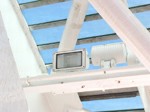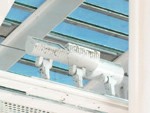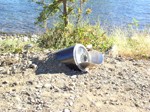skykeepers.org founded September 1, 1999
Vanishing Sacramento River Salmon - The Threat of Light Pollution
The Sundial Bridge may very well be a prime example of this threat.
The real threat is 120 hight power flood lights that illuminate the bridge and the river.
The purpose of this page is to review this issue in more depth.
For a start, the bridge is illuminated with 120 high power flood lights during night time hours some point up and down the river as can be seen from the photos. These flood lights shine up and down the river until 11:00 then only the upward directed fixtures remain on.
(1) Sundial Bridge, Redding -
Although this bridge is a wonderful sight and it has been described as environmentally sensitive, it is not environmentally sensitive with respect to night lighting. Lighting under the bridge should be considered a serious environmental threat. In regards to Salmon, it is noted that the shadow of the bridge was designed to be very small to protect the Salmon spawning beds above and below the structure. Research shows that light on newly hatched Salmon causes vision problems and reduced survival rates and can have a adverse effect on developing fish eggs. Lighting of the bridge presents a possible predator trap for wild salmon smolts migrating from areas above the Bridge. It is also conceivable that could facilitate taking of adult Salmon at night, although much less likely than on lower portions of the river. Research relating to these issued are sighted and clipped below.
Links -
, , ,
9/29/2004
, related -
Yes its beautiful at night and the day but what do the Salmon think? How would you like this above your babys crib every night?
Night Photo Links - , (Blog 13 Apr. 07), , ,
Related ECoANL *
* ECoANL Page 266 "Lights along a migratory watercourse may allowing increased predation by other vertebrate predators. Both inmigrating adult and out migrating juvenile salmon are captured by mammalian and avian predators, which can exert a significant pressure on depressed fish populations (Yurk and Trites 2000). "
* ECoANL Page 266 "Juvenile Pacific salmon begin downstream migratin while their eyes ae adapting to the dark (Brett and Ali 1958). This proecess takes between 30 and 60 minutes depending on species and age, during which time individuals are unavble to orient to fixed object and either swim with the current or are displace downstream (Ali 1995)."
* ECoANL Page 267 In a study of lighted and nonlighted areas along the Ceder Rive in Denton, Washington, Tabor et al.(2001) found increased nighttime lightning intensities to have a profound effect on sockeye (Oncorhyncbus nerka) fry. Increased nighttime light intensity, measured at lighted building and bridge sites, caused the fry to delay migration and move to the low velocity and lighted shoreline habitats. Downstream migration of sockeye fry each night was initiated after light intensity was less then 1 lux, a finding consistent with Ali's (1959) earlier research. When the light was artificially increased to 32 lux, however, migration almost completely stopped. "
Based on these and other references the lighted Sundial Bridge should be considered a significant barrier to downstream migration of wild salmon hatched above the bridge. Serious consideration of the effect of lighting on the spawning beds near the structure could not have possibily be considered. All this points to a serious flaw in the EIR process.
See: Impacts of Night Lighting, Predation & Light and Related News below
Other Related Links, Refercnces, Reports and Studies
Cedar River Salmon Saved By Shielding Light Fixtures, WSDOT Northwest Region, Bulletin No. 01-12, March 23, 2001 (skykeeper snip)"The Cedar River is where the largest run of sockeye salmon in the lower 48 states begins. Each year between January and June, several million salmon fry migrate from their spawning grounds east of Maple Valley to Lake Washington. The 2000 run was one of the biggest in recent memory, but the year before that was one of the worst, according to Roger Tabor, a fishery biologist with the U.S. Fish and Wildlife Service. Tabor has been working with federal, state, local and tribal governments to determine the reasons for the decline in the sockeye run. His research brought him to the Cedar River underneath I-405, where he noticed a problem. The lights that WSDOT installed to help keep trail users safe posed a threat to the sockeye salmon fry.
Light is basically a big stop sign,” Tabor said.
Sockeye like to migrate at night in the fastest part of the river channel and move to low velocity waters along riverbanks and river bottoms during the day. This way they avoid becoming the prey of fully-grown trout and sculpin, which like to forage at night. But the lights above the trail made the sockeye fry think it was daylight." ... Tabor estimated the lighting on the river resulted in several thousand salmon fry being eaten at this location in each spring migration period. ...
... After the first six shields were mounted ... The results were dramatic. Light readings showed that levels were similar to other nearby areas of the Cedar River that have no direct lighting. ...
The next evaluation was to see if the reduction in light led to a reduction in salmon fry on the riverbank. Again, the results were remarkable. ...
This account is referenced in * (ECoANL) Page 267-268 in reagard to "Disruption of Migration" as follows -
"Recent research has documented adverse effect of artificial night lighting on the migratory behavior. In a study of lighted and nonlighted areas along the Ceder Rive in Denton, Washington, Tabor et al.(2001) found increased nighttime lightning intensities to have a profound effect on sockeye (Oncorhyncbus nerka) fry. Increased nighttime light intensity, measured at lighted building and bridge sites, caused the fry to delay migration and move to the low velocity and lighted shoreline habitats. Downstream migration of sockeye fry each night was initiated after light intensity was less then 1 lux, a finding consistent with Ali's (1959) earlier research. When the light was artificially increased to 32 lux, however, migration almost completely stopped. Similarly, Prinslow et al. (1980) previously showed that security lighting caused a delay in chum outmigrating through a canal. Tabor et al. (2001) also documented increased predation on migrating fry by sculpin under artificial lights."
...
LIGHT
Direct light may have an adverse effect on developing fish eggs. The most detrimental rays are those in the visible violet-blue range produced by cool white fluorescent tubes. Pink fluorescent tubes, which emit light in the yellow to red range, are best suited for hatchery use.
The best practice is to keep eggs covered and away from direct light. In general, embryos of fishes subjected to bright artificial light before the formation of eye pigments will suffer high mortality at all stages of growth.
Daily Temperature Units (D.T.U. = water temperature(F) minus 32 F). Walleye eggs start hatching approximately 14-18 days after spawning (300 DTU), depending on water temperature. Eggs and fry of walleye tolerate rapid temperature fluctuations. Approximately 390 daily temperature units are required for eggs to hatch in fluctuating water temperatures, while only 230 daily temperature units are required at more constant temperatures.
... ** Does this relate to the conditions under and around Sundial Bridge at Night. MH lamps under the bridge have more blue and UV than noted above.
"The amount and incidence of light received during incubation can affect both fish development and larval survival. Therefore, all types of egg incubating containers should be stored in such a manner to protect developing embryos from direct light."
** Does this relate to the conditions under and around Sundial Bridge at Night.
"The amount and incidence of light received during incubation can affect both fish development and larval survival. Incubation of fish embryos should occur in either dim light or darkness. Light can also be used to synchronize hatching. Many species of fish will not hatch in daylight, therefore, if the lights are switched off, hatching will occur a few hours later."
"The most important environmental factors affecting larval growth and survival are: (1) light, (2) temperature, and (3) salinity.
(1) Light. The effect of light intensity and photoperiod on the growth and survival of larvae has received little attention in the past. Generally, fish larvae are reared either under continuous light or under day and night conditions. The few data accumulated to date show contradictory results. Rearing larvae under continuous light conditions has a positive effect on growth and survival for some species, but not for others.
It has been shown that high light intensities are detrimental particularly to the newly-hatched larvae. Light intensity must thus be controlled to optimize growth and survival. Young first feeding marine fish larvae have a feeding threshold of only 10 to 10 metre candle. Light intensities of 10 to 10 metre candle provide optimum feeding conditions." ** no idea what "10 to 10 metre candle" is, the point is high light intensities can be detrimental.
(.pdf) , WSDOT, 2005-06-10"Most salmonids exhibit light avoidance behaviors (Brookes 1988). Therefore, the removal of vegetation that decreases cover can limit the availability of preferred habitat for salmonids. To the extent that the removal of in-stream and streambank vegetation also reduces shading, water temperatures can be expected to increase. Changes in temperature can alter the rate of egg development, growth rates and rearing success, species competition, and community
composition (Beschta et al. 1987). "...
Notes on Fish Hatcheries --
A very interesting account of the history of the Coleman Fish Hatchery.
Predation & Light --
- "Seals wait in those shadows until they see juvenile salmon pass by in the lights overhead and then snatch them for a quick and frequent meal. The ease with which the seals are able to kill the salmon due to the lighting in that area are making it very difficult for the fish produced at the hatchery on the Puntledge River to make it out to sea."
"Dock lighting is also observed to induce temporary/localized delays by attracting fish, especially at nighttime. This is perhaps associated with prey attraction and/or visibility of prey." ... "Delayed migration of salmonids seems to happen when fish are confronted with conflicts regarding their preferences for eelgrass, dark areas, night lighting, or turbid zones."
With the exception of brief comments provided by Andrew Clarke of the Environment Agency, there appears to be little information regarding the potential effects of lighting on fish. Enquiries to clarify the lighting levels at which fish may be affected, have been
unsuccessful. The only practical comparator level is that produced by moonlight, which is generally accepted to be approximately 0.3-lux. However, it must be appreciated that this 0.3-lux level will be spread evenly over a large area of the river, and it is understood that problems arise where a bright band of light is present across a river, effectively forming a barrier through which fish may not pass. This is the typical effect produced by bridge mounted lighting, as demonstrated by the lighting design calculations. In order to minimise this effect, it will be necessary to restrict spill lighting to the bridge deck, by fitment of shields, or reduce the spill lighting levels on the river, to that produced by moonlight.
" In 1998, Stonehaven & District Angling Association secured a landmark UK court judgement on Light Nuisance (aka light pollution) which has attracted widespread interest from groups as diverse as biologists, civic societies, astronomers and others alarmed about the intrusive impact of ever-increasing artificial light sources on the natural environment and on the wellbeing of the individual. It is of particular importance to game anglers."
"This expert evidence revealed that seatrout, in common with most other nocturnal creatures, only night-adapt into an active roving and feeding role when natural light falls to between 0.5 and 0.2 Lux, owing "inter alia" to greater risk of predation at higher illuminance levels. There is also a concurrent switch from colour (cone) vision to black-and-white (rod) vision. The importance of this low illuminance underlines the widely held opinion amongst experienced seatrout anglers, that an unshaded full moon (around 0.3 - 0.2 Lux) is highly ominous to fishing success."
- City of Bellevue WA search [Potential Impacts of Shoreline Development]
"Pier lighting may facilitate nocturnal predation on juvenile chinook and coho salmon by visual predators like smallmouth bass, cutthroat trout, and piscivorous
birds."
"Shoreline development could potentially increase the rate of predation on juvenile chinook by several principal means: ...
4) providing artificial lighting that allows for around-the-clock foraging by predators; "
"extending the duration of predation by allowing visual predators to forage at night (piers with artificial lighting)."
"Alteration (slowing) of migratory behavior and subsequent increased sculpin predation rates on sockeye fry with increasing light intensity were observed in simulated stream experiments (Tabor et al. 1998)."
"14. Artificial lighting retards migratory progress of sockeye fry, subjecting them to increased predation. Lights from industrial areas in south Lake Washington facilitate nocturnal foraging by piscivorous birds."
"13. Do not permit shoreline or pier lighting unless future studies suggest otherwise."
, WSDOT Web Site
WSDOT’s Ferry Division hopes to light the way for migrating salmon in Port Townsend. A new research project is taking place at the Port Townsend Ferry Terminal that will assess how migrating fish respond to artificial light.
Studies have shown that structures like ferry docks cast shadows over the waters near shore and affect the migration of juvenile fish. Because the small fish are used to bright water, they avoid the dark areas and maneuver around the structures, driving them into deeper water where they are more likely to become prey for other fish and birds.
To counter this effect, WSDOT, along with the University of Washington and the Pacific Northwest National Laboratory, are installing a fiber-optic lighting system under the Port Townsend Ferry Terminal to encourage fish to migrate under the structure. A solar power system above the terminal will run the lights during the day in an attempt to match sun levels in open water. ...
, Appendix B Page 5 October 2006
s, January 2006 Page 8
"Keeping the illuminated area and intensity of nighttime lighting to the minimum that is necessary for the intended purpose. Workers will direct lights onto the work areas and away from the water. "
See also, "The salmon lovers return to Old Sac" below.
It is apparent from a review of WSDOT and other Pacific Northwest resources that far more attention is paid to the relation of Salmon and local lighting conditions than is apparently exibited in California.
See News Stories and other links at Vanishing California Salmon
Echolocical Light Pollution - skykeepers.org
zooplankton
- We investigated also the effect of light on the carnivorous feeding of both pelagic and littoral mysids. Highest feeding rate of pelagic mysids was observed in total darkness but littoral mysids were not affected by light at all. This may be explained by different habitats and the prevailing light conditions in these environments. Pelagic mysids are used to migrate to deep water when light increases to avoid fish predation, thus they are not used to feed in light. In the littoral zone, on the other hand, mysids are used to bright light and their feeding is not hampered by it ().
It has been shown that freshwater pelagic mysid shrimps capture zooplankton at a higher rate in light than in darkness. ... The feeding rates of pelagic mysids were significantly higher in total darkness than in light. In contrast, the feeding rates of littoral mysids did not differ in the dark and the light in the three different seasons. ...
* (ECoANL) Ecological Consequences of Artificial Night Lighting, By Catherine Rich & Travis Longcore
Chapter 11 Artificial Night Lighting and Fishes
Contributors Barbara Nightingale, Travis Longcore and Charles A. Simenstad
.
Home


